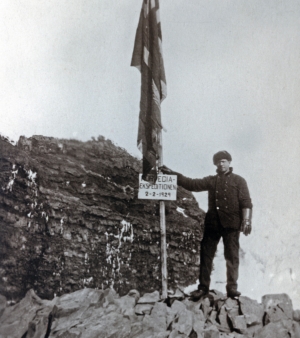Did you know that Peter I Øy was once a fiery volcano?
But like of the rest of Antarctica, Peter I Øy (Peter I Island) has long been covered in snow and ice.
 The second Norvegia expedition, led by Ola Olstad, annexed the island for Norway 2 February 1929. Photo: Norwegian Polar Institute
The second Norvegia expedition, led by Ola Olstad, annexed the island for Norway 2 February 1929. Photo: Norwegian Polar Institute
Fabian von Bellingshausen was probably the first who came close enough to catch sight of the Antarctic Continent. That was during his expedition on the sailing vessel Vostok, in January 1820. One year later, 11 January 1821, he spotted land in a completely different part of Antarctica. That was the day he discovered the island he named after the Russian czar: Peter I Øy. The island lies in the Amundsen Sea in West Antarctica, about 450 kilometres west of Ellsworth Land on the Antarctic Peninsula.
The weather was too rough for von Bellingshausen and his crew to go ashore on the island they had named. We don’t actually know for certain whether anyone ever set foot there before Ola Olstad and the crew of Norvegia landed on 2 February 1929 and annexed Peter I Øy to Norway. The island was declared a Norwegian dependent territory in 1931.
Peter I Øy is relatively small – just 156 km² – thus being a bit smaller that Bjørnøya in the Barents Sea. Most of it is covered with ice; only about 5% of its surface is exposed. Peter I Øy is volcanic and the highest point on the island is the top of the extinct volcano’s crater, towering 1640 metres above sea level. The peak has been named Lars Christensentoppen after the whaling magnate who financed the expedition that annexed the island in 1929.
Because of the pack ice that surrounds the island, and the precipitous mountain slopes that plunge straight into the sea, it is very difficult to go ashore on Peter I Øy. There are only three places where boats can be landed. Strong winds and savage cold and snow in the region have ensured that very few people have ever set foot on this island.